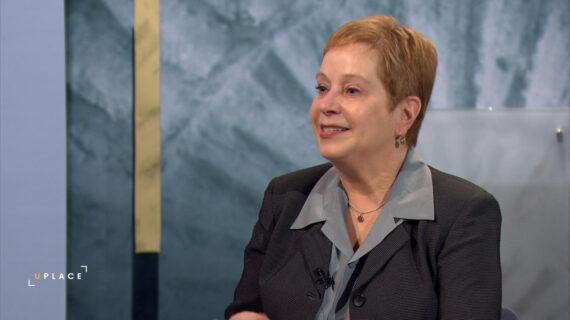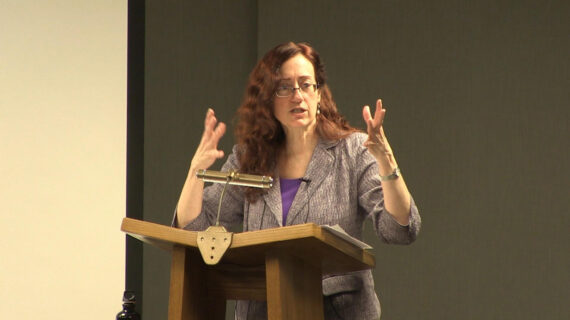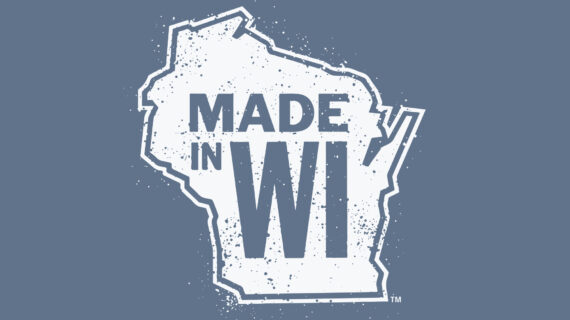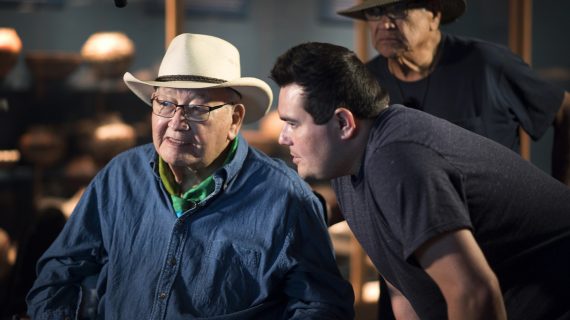Today, we are pleased to introduce Jillian Jacklin as part of the Wisconsin Historical Museum’s History Sandwiched In lecture series. The opinions expressed today are those of the presenter and are not necessarily those of the Wisconsin Historical Society or the museum’s employees. Jillian Marie Jacklin is a PhD candidate in the Department of History at the University of Wisconsin-Madison. She is a historian of the United States, with a focus on labor and social movements as well as comparative and transnational history. Inspired by methods in cultural analysis and critical studies, Jillian explores the role of gender, race, ethnicity, and religion on working-class lives, both on the shop floor and out in the community. Jillian grew up in Appleton, Wisconsin, and her family and childhood inspire her activism and scholarship. Please join me in welcoming Jillian Marie Jacklin. [applause]
– Well, thank you, Katie, for organizing the talk and to the Wisconsin Historical Museum for having me here today, as well as all of you for coming and listening to me talk about Vaudeville, Vagrants, and Vice: Working-class Leisure and Social Control in the Paper Valley. This talk is part of a larger project, which is my dissertation, “Paper Dreams: Working Class Cultures and “Political Drift in the Fox River Valley,” which covers the time period from the 1870s through the 1950s. These are some of my major research questions that I’m hoping to answer with the five chapters of my dissertation. This talk pulls from the third chapter of my project. I’d like to focus your attention here to the map, and specifically the Fox River. The power of the river is what first attracted industrialists to the region. Falling nearly 170 feet over 35 miles, the river, the Fox River uniquely flows north, dropping a height nearly to that of Niagara Falls. In the late 1870s, local businessmen and commercial investors harnessed the Fox’s hydropower to produce lumber, flour, textiles, and most importantly, paper.
So, growing up in the area, I became really interested when I came first to college at UW-Madison and then began my graduate work in uncovering why the area is known for its social conservatism. It maybe isn’t so much in this state, per se, but nationally the area is known for its political and social conservative, having been the birthplace of Joseph McCarthy and, also, it’s currently the home to the John Birch Society, a conservative political think tank. So my talk today focuses on the Fox River Valley during the Progressive Era.
Now, scholars continuously debate which years constituted the Progressive Era. Whether or not it was from 1900 through the 1920s or maybe a few decades earlier. And scholars also argue over the meanings of progressive as a cultural ideology and also progressivism as a social and cultural and political movement. So I’m interested in what the era was like in the Fox River Valley, in particular what progressive meant there and who would have been considered progressive at the time. So, we will unpack that a bit more. It’s important to note here, though, that when we talk about progressive politics at the turn of the 20th century, we don’t mean the same thing that we meant today. Right? Progressive meant something different then, and it meant different things, of course, to different people, as it does today. Paper production was one of several economic experiments that capitalists initiated during the second half of the 19th century in Wisconsin, with Appleton boasting the valley’s first paper mill as early as 1853. Manufacturers developed other factory operations devoted to the growing wood products industry in the 1860s and 1870s, but paper production did not become big business until the last decades of the 19th century when local boosters drew capital and labor into the region. Valley promoters imagined a riverside landscape busy with paper mills, and their visions became a reality by the end of the century.
During the mid-1880s, eastern investors and area industrialist devoted abundant capital to papermaking in the Fox Valley, and local national resources supported production of the commodity. The river in vast Menominee timber stands just to the north of Oshkosh and Appleton provided the natural resources necessary to support the expansion of local industry and corporate capitalism. As a result, entrepreneurs converted failing and abandoned flour mills into paper and woodenware factories. Not long after, the area earned a reputation for industrial progress and innovation in the processing of lumber and its byproducts, not only locally but across the United States. By the late 19th century, local promoters boasted that the valley had become a national leader in urbanization, industrialization, scientific management, and technological progress. Fueled by the first hydroelectric operating station, on September 30, 1882, Appleton, Wisconsin, became the second city in the United States to have centralized electrical power. A momentous occasion, this marked one of several firsts that area business advocates and local factory owners celebrated, highlighting the progressive character of the Fox River Valley. For 30 years, the valley also enjoyed one of the first and longest-operating streetcar systems in the US. In response to these accomplishments, the local press and prominent businessmen touted the modern advancements of area communities.
The Appleton Post bragged, “Verily this is a progressive age, and Appleton keeps abreast of the time in everything.” Local businessmen and wealthy elites viewed their city as progressive as a result of its technological advancement and industrial development. Contemporary onlookers would have considered the expansive paper mills and woodenware factories to be signs of progress that brought jobs and modern conveniences to the region. Not because they embraced social equality necessarily, though. In reality, these modern advancements relied on the labor and often unfair treatment of area workers. Local factory owners developed a business philosophy founded upon the idea that the riches of industrialists rested on keeping their workers in rags by maintaining low wages and also on developing tactics to shape working-class life, both in the factory and out in local communities. At the turn of the 20th century, Fox River Valley factory owners were desperate for a steady, reliable, and abundant labor supply. Yet, simultaneously, they wanted to encourage maximum profits. George Paine, owner of the successful Oshkosh lumber company, for example, believed like his counterparts, Kimberly-Clark, in the paper industry, that supplies should cost more than workers. This created a conundrum, given the transient nature of the post-Civil War era workforce and competition for workers with eastern manufacturers and the extractive economies of the west.
A strict and devout work ethic guided Paine’s managerial philosophy, which affected his ability to maintain a labor force. Like the paper barons who owned Kimberly-Clark, Paine Lumber emphasized new machinery and innovative ideas in scientific management, including uniformity, efficiency, and the division of labor. Central to both industrial operations was an entrepreneur’s personal control over its business. Wisconsin industrialists in both woodenware manufacturing and paper production experimented with techniques that sought to place all authority in the hands of owners and their managers. Yet workers had desires and dreams like anyone else, and these hopes influenced the Oshkosh woodcutters strike, a nationally publicized labor action. On August 13, 1898, an unidentified newspaper published the struggles of local woodworkers and their efforts to improve worker conditions and wages in the valley by releasing an editorial title “Wage Slave of Oshkosh are Starved “by Their Republican Masters.” Through the importation and exploitation of “cheap foreign labor,” Oshkosh earned the title of the slave wage capital of the world. Interestingly, though, although over half of the strikers were women and children who earned not even half the wages that the male strikers did, the strike actually undermined the efforts of a number of workers, at least women and children workers, as many of them lost their jobs after the strike. The growth of the papermaking and woodenware industries physically changed the landscape of the Fox River Valley due to their reliance on natural resources. But the cultural transformation of the area was just as profound.
The expansion of corporate capitalism and increased white settlement that accompanied it recreated the social train in ways that threatened the hegemony of local industrialists and their way of life. Newcomers brought their own set of values with them as they arrived to the region. And working-class economic perspectives and leisure practices did not necessarily align with those of their employers and local industrialists. Not only did immigrants and transient workers bring their diverse customs and belief systems with them, but many had experienced injustice before and were unwilling to accept it in their new home. Instead, they resisted on fair labor conditions and struggled to shape their surrounding communities to reflect their preferred lifestyles. So, Oshkosh was known not only for the Oshkosh woodcutters strike but also as Sin City at the turn of the 20th century. It gained an infamous reputation for having quite the leisure scene, with cheap laborers and a more transient workforce encompassed by single men and also lots of single women, which was pretty scandalous at the time. Gambling, drinking, and also prizefighting. This is a picture of Jim Hall, who was an Australian prizefighter, who had frequented the gambling and drinking scene in Oshkosh.
He’d made several appearances there and was considered “a world-class drunk with a bad temper.” [laughter] He died in Neenah, actually, in the early 20th century. A side effect of industrialization and urbanization was an emergence of a commercialized leisure sphere, where workers spent their wages on entertainment and “vices” that middle-class reformers viewed as corrupting. A commitment to maintaining working-class morality was both a local and a national preoccupation during this time. In the Fox River Valley, the Young Men’s Christian Association provided the institutional framework for social reformers to encourage morality and industriousness among factory workers. Lawrence University housed one of the first YMCA chapters in Wisconsin, which began its missionary efforts in 1870. Devoted to “aggressive Christian work among college students,” the organization also emphasized volunteer activities among the student body. Like the national association, the local YMCA chapter sought to raise “the moral standard in the surrounding community.” Although the work remained Christian in focus, the reform movement was less interested in salvation and more concerned with providing “an ameliorative social environment “for young men displaced by the Industrial Revolution.” In response to concerns about the undesirable leisure activities and drinking habits of immigrant workers, the YMCA sought to encourage alternative forms of recreation and socializing that promoted moral uplift among industrial employees. To do so, the organization offered bible classes and Sunday school services at churches in working-class neighborhoods and encouraged “fellowship and association “in a Christian setting.” Hoping that these activities would make religious institutions the social centers in the districts in which they situated, the organization promoted greater faithfulness and order among workers in the paper industry and among employers who worried about working-class activism. By promoting cooperation rather than confrontation, the organization benefited local factory owners and their commercial goals in the valley.
According to one scholar, capitalists and their supporters in local government believe that the area had problems with “drunkenness and vice “associated with large-scale factory employment.” The YMCA offered a potential solution to these impediments to corporate progress in the region, so local elites supported the organization. One popular form of leisure in the late 19th was blackface minstrelsy. A 19th popular form of entertainment that characterized African Americans as both lazy and unintelligent. In most cases, white men played the roles of black individuals, though there were some black actors who performed under white male directors. Minstrelsy was the precursor to vaudeville, which also portrayed African Americans as inferior. These are a couple pictures that I found in the Lawrence University archives. A number of the student body, particularly the men, actually worked in local paper mill factories and would participate in these vaudeville performances where they would really mock homeless people, vagrants, and also specifically Irish workers at this time in the area. So this image here, on the left, is an illustration of what would have been considered an Irish hobo at the time. So vaudeville and variety shows actually offered a break from the drudgery of work life.
And, along with ideas about race, workers learned about ideas of revolution. Employers worried that this type of leisure would get workers together and encourage organizing. And they were not wrong. Workers did use these sites for sharing information and networking. And they also learned a lot about Harry Houdini, who actually lived in Appleton for about five years. He was born in Hungary, and his father was one of the first rabbis, actually, in Appleton. Again, they lived there for five years before moving to New York City, but Harry Houdini did visit the Fox River Valley a few times when he would perform in local circus acts and vaudeville performances. He started out his career as a trapeze artist at nine years old but then, I imagine that many of you know, he ended up doing a lot of different escape artist acts. And, really, he promoted a sense of revolution and justice amongst workers through his performances.
This idea that no matter what was getting them down at the time, that they did have the opportunity to escape. And his revolutionary message was profound, as were the messages that workers sort of imbibed when they would partake in these variety and vaudeville shows. One piece of evidence of the effect that these leisure activities had on workers was the rise of Wisconsin’s progressive Republicans. In 1900, a coalition of social reformers, farmers, and workers came together to propel the progressive branch of the Republican Party into power in Wisconsin with the election of Fighting Bob La Follette. The politician and his supporters helped to limit the influence of corporate power and industrial greed over local and state matters, encouraging a number of different reform measures and laws to protect workers, including the first workman comp laws and also child labor laws, and especially notable was the adoption of the direct primary system, which sought to decrease the effects of untrammeled crony capitalism. This was especially important in the Fox River Valley because the majority of political offices were held by industrialists and their managers up until this point. So, in reaction to these forms of vice and leisure that maybe promoted revolution amongst workers, industrialists and social reformers, throughout the late 19th and early 20th centuries, planned recreational spaces as gathering sites to discourage the influence of vice on the local working-class population. Designers used the “White City,” an exhibit from the Chicago World’s Fair in 1893, as a model for these places, which were primarily parks that encouraged wholesome and family-oriented leisure. If you were to take a tour around the valley, you’ll notice that a lot of the parks are actually named the White City or White Park or had been in the future, if they have some sort of historical marker on them.
Another tactic that industrialists used along with social reformers and public workers were anti-vagrancy laws. During the late 19th and 20th centuries, communities across the nation created laws that restricted the movement and lives of migrant laborers and transient workers who could not or chose not to live in one specific location. Industrialists and their allies in local government created these laws as tools in order to divide workers along the lines of class, race, age and gender, and also lifestyle choice. So here is an article actually from the Chicago Tribune. It says, “What race makes the best hobo? Good tramp never works.” So there were actually a lot of these articles in the Chicago Tribune, the New York Times, also more local newspapers sort of classifying the ways that people lived along racial and ethnic lines. Very interesting. Also gendered lines. These would usually be single, white men who are portrayed in these advertisements. So vagrants were often targeted by race.
Local businessmen drew on stereotypes that African Americans were unintelligent criminals and untrustworthy vagrants, often the stereotypes that were promoted by vaudeville and blackface minstrelsy. And employers projected these characteristics upon southern European and Irish migrants as well, as we saw in the images earlier. With the assistance of law enforcement officials, local elites sought to maintain an image of a lily-white city by discouraging the foreign element from residing in the area. This resulted in an anti-vagrancy ordinance the police officers individually applied to “blacks, eastern and “southern Europeans, and Oneida from the adjacent reservation.” Similar to their treatment of African Americans, American Indians, and certain European immigrant groups, the police targeted Irish newcomers as well as citizens in an attempt to keep these individuals out of the city. As one local newspaper reported, officials wrongly arrested two Irishmen and an African American man under Appleton’s anti-vagrancy law, even though the three men were residents of the area. PH Smith, one of the victims of the incident, claimed that the city “was not for colored folks.” If one was able to stay in the city overnight and avoid police harassment, they then had to find a place to live and work. By the end of the 19th and into the first three decades of the 20th century, as more women entered the expanding industrial workforce nationally, local social reformers thought to influence the public compartment of working-class women. Middle-class activists and local elites understood that women workers would spend more time with men while on the job but did not approve of social interaction between men and women off the shop floor. As more working-class women, generally young and single, entered the workforce in local paper mills and woodenware factories, they found themselves with new freedoms that they did not experience at home with their families.
Differently than in Victorian society, the expansion of corporate capitalism created commercialized forms of entertainment that brought men and women together. This development created anxiety among local reformers and industrialists, because they worried about the moral corruption of working women. As a result, they encouraged industrial workers to stay away from saloons, billiards, dance halls, and other popular venues that permitted heterosocial contact. To keep working-class women away from undignified social behavior, middle-class reformers in the valley and across the US advocated for a “Christian womanhood,” which they believed would help to improve the status of women. Organizations like the YWCA responded to a national call for “Woman’s Work for Woman” by forming local chapters like the one at Lawrence University in 1884 in order to encourage domesticity among area workers. Activists wanted to change working-class cultural practices in order to uplift factory workers morally, believing that regulated leisure activities would provide opportunities for acceptable forms of sociality. By creating these spaces, reformers hoped that they would “teach standards of womanly deportment and respectability” that would counteract the corrupting elements of commercialized entertainment. The possibility that women factory workers would take up prostitution was a primary concern of industrialists and middle-class residents. With little legal restriction locally against selling sex, the YWCA sought to curb working-class vices by endorsing rational recreation that kept women away from bars and hotels that permitted interaction between men and women.
This reflected not only a local but also a national problem for moral reformers, who worried about the shifting role of women in an increasingly industrialized society. Despite the efforts of the YWCA and other social reform organizations to curb sex work however, their efforts were largely unsuccessful. The cultural byproducts of industrial progress continued to cause challenges for establishing social order locally and the US more broadly. As a result of the efforts of area industrialists and progressive reformers in manufacturing regions like the valley to influence the behavior of working-class people, especially their leisure practices, these vice crusaders conducted campaigns in at least 30 cities throughout the nation, publishing reports and pursuing widespread investigations in their search to expose the immoral activities of workers, who were often young, single women. Although 19th century moral reformers viewed sex workers as victims and sought to reform those involved in the local prostitution market, public officials rallied to make selling sex a crime. This was part of a larger project to ameliorate the consequences of industrial expansion and corporate capitalism on the part of progressives as well as a way to manage the lives of workers more generally. Wisconsin was a hub of the social ferment and advocates of outlawing prostitution were prevalent in the valley. Under the progressive administration of Governor Francis McGovern, the state legislature passed several anti-vice laws that sought to undermine the corrupting effects of commercialized nightlife and regulate the daily necessities and amusements of working-class people. This picture, on our right here, is a page out of the Appleton Police Department’s arrest records from 1906.
I don’t think that you can see from the audience, but the column on the way right has the different crimes that people were arrested for. And most of them say either drunk, tramp, or vagrant. And it’s like this, actually, throughout the arrest records, and it’s primarily single men that were arrested by local police departments. Young women, on the other hand, who were thought maybe have been, were accused of being involved in the local sex working market were often sent to reform schools or sanitariums for places that people thought young women had gone crazy. In Wisconsin, the movement to end sex work climaxed with the formation of the Teasdale Vice Committee and the enactment of the Linley Law in 1913, which effectively outlawed organized vice in the state. Members of the government commission, tasked to investigate the prevalence of what was called white slavery, sought to encourage the enforcement of the slew of moral codes that the state legislature approved, hoping to persuade county district attorneys to implement the laws. They had a difficult time doing so. Headed by state senator Howard Teasdale, the committee worked to correspond with local reform organizations and public officials who supported their cause. The politicians did receive feedback from Fox Valley residents who worried about the corrupting effects of prostitution.
For instance, on August 20, 1913, a concerned citizen wrote in that a man by the name of Smokey was “keeping a bad house,” and one month later, the mayor of the city of Berlin contacted the commission to express his confidence that there was “a house of ill fame” in his community. Over the course of a two-year period, public officials involved in the campaign received hundreds of letters confirming the existence of sex trafficking and prostitution in Wisconsin. Foundational to the approach to discovering these illicit activities and the locales that accommodated them, was to create a network of accomplices in area communities to foster a climate that was hostile to these immoral pursuits. To do so, the vice committee attempted to infiltrate the bureaucratic frameworks of county governments and also paid social reformers to work as spies in local vice districts. This required some careful planning on the part of investigators, who devised ways to collude with powerful people. For example, on September 25, 1913, Winford Adams, the mayor of Green Bay, wrote a letter in response to inquiries from the legislative committee suggesting a list of officials that could possibly help with their efforts. This list included five religious officials, the chief of police, a criminal court judge, a former mayor of the city, and three local insurance agents from Northwestern Life. Similar correspondence came in from Menasha and Kaukauna, two important industrial communities in the valley, and the mayor Fond du Lac offered a directory of “very prominent people who had a great interest “in eradicating vice from their municipality.” Although the members of the legislative commission made some connections with sympathetic local leaders, like the one from Fond du Lac, and social reformers did work tirelessly to administer the moral laws of Wisconsin, the anti-vice campaign had little success. In some cases, attempts at forming relationships with mayors and county representatives around the state succeeded, but in most situations these endeavors were ineffective and sometimes they even backfired against the cause.
According to the report of the legislative committee, the Linley Law was “purposely framed to bring responsibility home to the district attorneys and private citizens in the area.” So they had to rely on local public officials and citizens to turn people in for participating in sex work and drunkenness. Rather than have permission to carry out the law, police officers needed to be compelled to do so by local residents. To return to the question from the beginning of my presentation, why did the area shift to being so conservative? It’s really interesting and it may have to do with the criminalization of these types of practices. According to the Wisconsin Vice Commission, the problem rested in the hands of inefficient law enforcement officials and private citizens who were overindulgent and too prone to let law-breaking pass unpunished. Individuals were unlikely to inform local authorities of suspicious activity regarding sex work in their neighborhoods, because they might have suffered business ostracism, or maybe even boycotting, as a result of making complaints against their neighbors who were “doing wrong.” Police officers failed to implement the anti-vice laws for various reasons, one being their personal relationships with people and other being financial. For instance, Edmund Fitzmaurice, the mayor of Berlin, explained that the cousin of the chief of police was the one who ran the house of ill fame that existed in the city. Rather than turn his family into authorities, the officer safeguarded her and received money in exchange for his efforts. As influential in the failure of public officials and private citizens to report this woman to the district attorney was her connections to a local brewery. According to Fitzmaurice, the particular sex worker was a significant purchaser of alcohol from the business, and, as a result, the brewing company would protect her.
The working woman had her own network of local supporters. The pictures up here, the one on the left is an advertisement suggesting that maybe females shouldn’t be working outside of the home. And this other one here is a picture from a local Oshkosh brothel. The effectiveness of the law came down to enforcement on the part of government officials as well as resistance against these regulations by people who participated in the social evils, or what they viewed as employment or popular amusements. Those invested in the local prostitution market resisted in order to make enough income to pay their bills and, according to sex worker June Darlington, to enjoy “the luxuries in life.” When Teasdale interviewed this Wisconsin sex worker, she explained that she had no interest in refraining from the business to work in a factory as a domestic for only $6 to $8 a week. She, like anyone else, was going to spend her free time as she wished and have the same comforts as any other women, because “it was perfectly natural for her to want them,” and she would not rely on men to provide them for her. Instead, she claimed that there were plenty of other women who were getting it just the same as she got hers. Darlington was not going to stop participating in the prostitution industry. When government officials tried to outlaw white slavery in urban entertainment venues and rural saloons, they had little success.
Those working women who sold sex in exchange for money viewed their profession as superior to factory work, and, in many cases, they enjoyed their profession. In these ways, working-class people influenced the shape of Progressive Era politics and reform efforts, as well as corporate designs for cultivating social order and a moral and industrious workforce in the region. Industrialists actually hurt themselves by keeping wages low and doing little to improve to the conditions under which their workers toiled. Employers could not control their workforce. Workers were going do what they needed in order to survive and enjoy their lives. This picture here is a picture of a bunch of underage people drinking at a local saloon in Appleton. Depending upon the community and the perspectives of municipal politicians and their relationship to local businesses, the legislative committee organized to conduct the investigation received different information and varying levels of support. Howard Teasdale’s strategy had mixed results. The outcome had to do with his audience as well as the cultural and political landscape of the community within which he and his committee members were hoping to form a working relationship.
So these are just the questions that we’re returning to from the beginning. Again, these are the questions for my larger dissertation project. This information today is specifically from chapter three. But my findings suggest that the conservative shift of the valley was more of a conversation than a one-directional struggle for social change. Working-class people negotiated with business owners, religious leaders, government bureaucrats, and amongst themselves over whether or not sex work should exist in local Wisconsin communities, as well other vice pursuits, or leisure pursuits as they probably thought of them as. The standpoint that a person had regarding the selling of sex or other working-class leisure establishments had to do with their class status but also their cultural values, religious practices, and perspective on progressive-era debates about morality in general. A central component here was gender and beliefs regarding the proper behavior of women in public settings. Sex workers themselves had varying degrees of respect for their profession and opinions about whether or not the industry should have existed at all. Getting at the heart of this debate, however, has been very challenging given the lack of sources.
Perhaps as I continue to research this commission and also this topic to understand the lives of people who participated in sex work and other leisure pursuits in the valley during the Progressive Era, I will hopefully have uncovered some of the perspectives of people who maybe not have been as represented in the historical record. I’m really interested in representing the voices of women who sold their bodies, not just for survival but also possibly as a form of pleasure or empowerment. This presentation provides a preview of the information that I have found in my quest. So, I’m very interested in your comments and questions at this time. Thank you. [applause]
Search University Place Episodes
Related Stories from PBS Wisconsin's Blog

Donate to sign up. Activate and sign in to Passport. It's that easy to help PBS Wisconsin serve your community through media that educates, inspires, and entertains.
Make your membership gift today
Only for new users: Activate Passport using your code or email address
Already a member?
Look up my account
Need some help? Go to FAQ or visit PBS Passport Help
Need help accessing PBS Wisconsin anywhere?

Online Access | Platform & Device Access | Cable or Satellite Access | Over-The-Air Access
Visit Access Guide
Need help accessing PBS Wisconsin anywhere?

Visit Our
Live TV Access Guide
Online AccessPlatform & Device Access
Cable or Satellite Access
Over-The-Air Access
Visit Access Guide
 Passport
Passport


















Follow Us